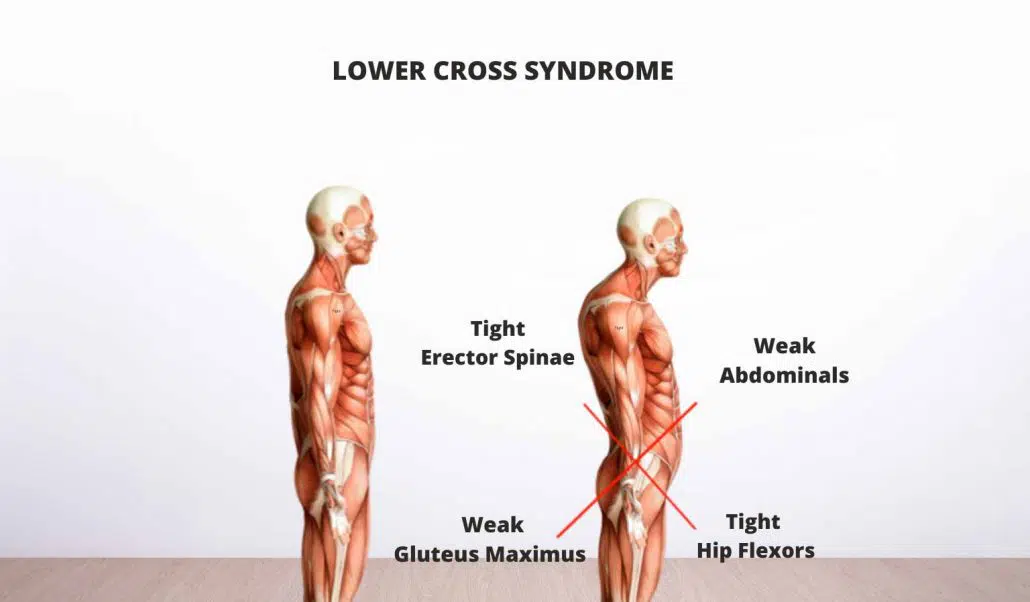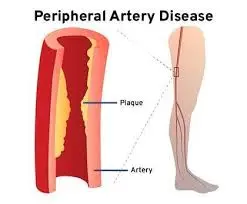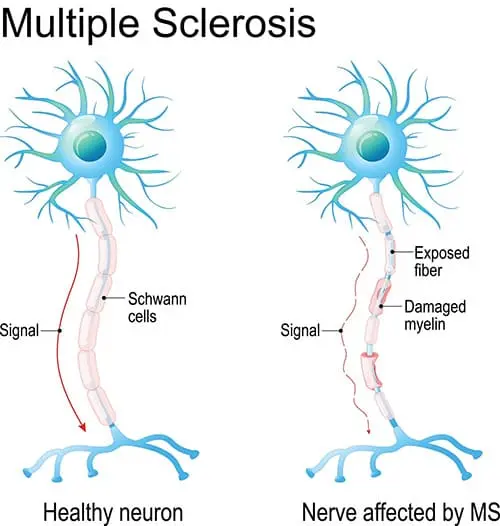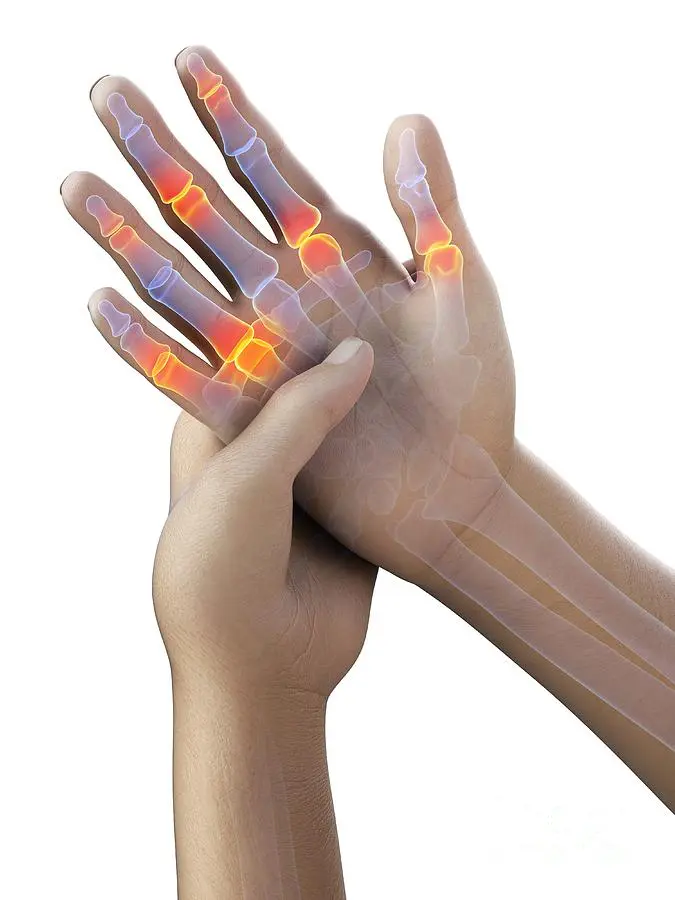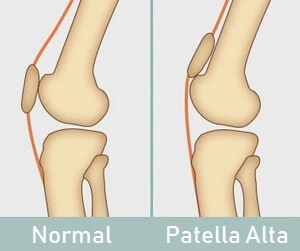Lower Cross Syndrome
What is a Lower Cross Syndrome?
Lower Cross Syndrome (LCS) is a postural imbalance that affects the lower back and pelvic region. It is characterized by a pattern of muscle imbalances where certain muscles become tight and overactive while others become weak and underactive.
Both the dorsal and ventral areas of the body are affected by this syndrome, which is typified by a high frequency of muscle weakness and stiffness.
The cross-shaped affected muscle is where the name Lower Cross Syndrome originates.
Patients with lower back syndrome (LCS) have altered posture and gait due to tightness in the hip flexors and the lumbar erector spine, a group of muscles that extend. To make up for these limitations, the person tilts their pelvis forward and arches their lower back.
Clinical relevant anatomy:
Reduced gluteal strength (gluteus maximus, gluteus medius, and gluteus minimus) and trunk strength (rectus abdominis) are traits of lower crossed syndrome. Inhibited muscles take the place of the superficial muscles when they become aroused.
Hip flexor muscles (iliopsoas and tensor fasciae latae) and thoracolumbar extensor muscles (erector spinae, multifidus, quadratus lumborum, and latissimus dorsi) coexist with hyperactivity and tightness.
Causes of Lower Cross Syndrome:
These muscles are susceptible to weakening:
The trunk muscles consist of:
- Rectus abdominis
- Obliques internus abdominis
- Obliques externus abdominis
- Transverse abdominis
The gluteal muscles consist of:
- Gluteus maximus
- Gluteus medius
- Gluteus minimus
Thoracolumbar extensors include:
- Erector spinae
- Multifidus
- Quadratus lumborum
- Latissimus dorsi
Hip flexors include:
- Iliopsoas
- Tensor fasciae latae.
Poor posture, a sedentary lifestyle, or leisure activities such as working at a desk, watching a lot of television, using a computer for extended periods of time, or engaging. An increase in stress on those specific muscles is the cause. A lack of knowledge about how to perform daily tasks or incorrect posture or form when exercising might result in one-sided stress or excessive tension in certain areas of the muscles.
Symptoms of Lower Cross Syndrome:
LCS can cause pain throughout the body, impair mobility, and have an impact on a person’s posture. Additionally, people may experience:
- Reduced range of motion or stiffness in the hip, pelvic, lumbar spine, or pelvis.
- Anterior pelvic tilt, lumbar lordosis, lateral lumbar shift, and external hip or knee hyperextension and rotation are examples of postural abnormalities.
Features of type A posture:
- Hyperkyphosis: The upper back rounder in a person with this condition.
- Hyperlordosis.
- Anterior pelvic tilt
Type A: Posterior pelvic cross syndrome:
The posterior pelvic crossing syndrome is a type A subgroup. linked to an enhanced thoracolumbar extensor activity, which causes the thorax to translate anteriorly. Breathing and postural control become less effective as a result.
Example:
The patient will elevate their thorax during the inspiration action, resulting in an upper chest breathing pattern. Because the abdominal muscles are unable to pull the thorax back into the more expiratory neutral posture, the active expiration will be challenging.
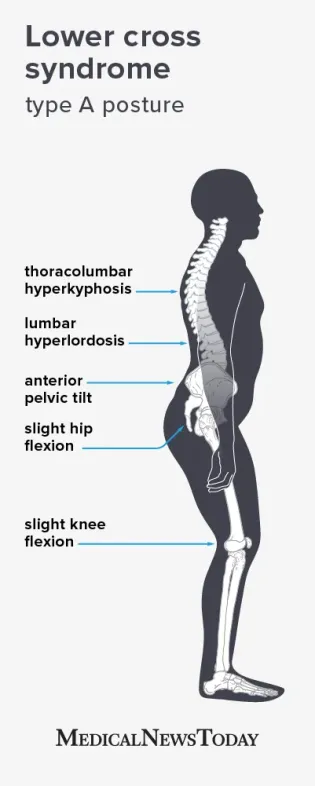
Type B: Anterior pelvic cross syndrome:
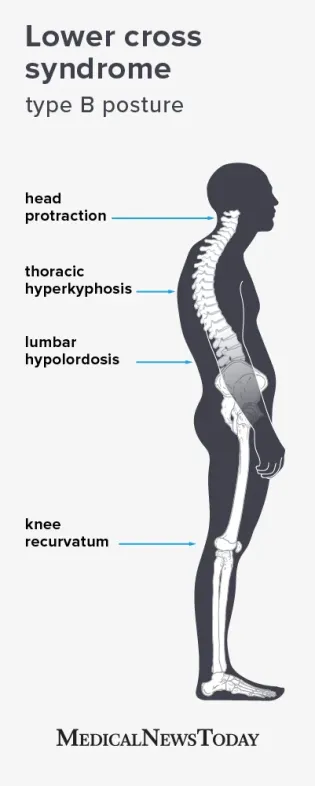
What Individuals Are Most at Risk of Lower Cross Syndrome?
Although the risk factors for Lower Cross Syndrome (LCS) can differ from person to person, the following are some common variables that increase the likelihood of having LCS:
- Sedentary lifestyle: Individuals who lead lives or have occupations that necessitate extended periods of sitting could be more vulnerable.
- Poor posture: Retaining bad posture, such as hunching over or sitting with an excessively bent lower back, can aggravate lower back pain (LCS). Muscle weakness, irregularities in the structure, and habits can all contribute to poor posture.
- Lack of exercise: The gluteal and abdominal muscles, which are crucial for preserving the normal alignment and stability of the lower back and pelvis, might become weaker as a result of insufficient or irregular exercise.
- Muscle imbalances: An increased risk of LCS can result from imbalances between opposing muscle groups.
- Past trauma or surgeries: Trauma or surgeries to the hips, pelvis, or lower back can throw off the body’s natural muscular balance and increase the risk of lower back syndrome. For example, having a history of hip problems or low back pain may make LCS more likely to occur.
- Hereditary factors: Some people may be more prone to developing LCS due to a hereditary predisposition to specific muscle imbalances or structural abnormalities.
- Factors associated with sports or the workplace: Participating in sports or jobs requiring repetitive motions, extended standing, or a lot of strain on the hip and lower back muscles can raise the risk of LCS. Jobs requiring the lifting of large objects or sports involving sprinting or jumping are two examples.
It is noteworthy that the presence of these risk factors does not ensure the development of LCS; individuals may still develop the illness in the absence of these factors. Furthermore, LCS does not always result from the presence of risk factors. Regular exercise, proper posture, and getting treated for any underlying conditions can all help lower the chance of LCS or lessen its symptoms.
What dysfunctions are associated with Lower Crossed Syndrome?
The SI joint, L4-L5, L5-S1, and hip joints where the pattern intersects can all experience functional impairments. In addition, it may result in plantar fasciitis, knee pain, ankle dysfunction, low back pain, and iliotibial band syndrome.
When should I visit a doctor?
This could cause soreness in the lower back. It’s also a good idea to see a doctor before starting any new exercise regimen, especially one that aims to help correct someone’s posture.
Diagnosis
Lower Crossed Syndrome Examination:
- This illness may be diagnosed using a combination of specialized evaluations and a physical examination.
Active examination:
- Hip extension movement: This is assessed to see whether the hip is hyperextended during walking. Lift your straight leg.
- Hip abduction movement
Other special assessments are the following:
- Overheard Squat: Pay attention to the lower back arch position throughout this examination.
The patient experiences an increase in lower back arch and excessive forward bending when squatting. - Single-Leg Squat: The doctor will watch your forward lean and trunk rotation when you complete a single-leg squat.
The patient’s knee went into a valgus position during this movement, which the doctor also observed in the LCS patient. - Pushup: If the patient’s hips drop to the floor and their lower back arch increases during the pushup assessment, this may be an indication of lower crossed syndrome.
Treatment of Lower Cross Syndrome:
Medical treatment:
In case of extreme pain, the physician prescribes analgesics or over-the-counter pain relievers and suggests using hot and cold packs on the affected region.
For lower back pain, patients should take the medication that their doctor prescribes; they should avoid taking any other type of medication.
The main goals of exercise for LCS treatment are to improve weak and tense muscles that are affected by this condition and to relieve pain.
Physical therapy treatment in Lower Cross Syndrome:
A therapist develops a successful program for the patient and offers general direction. Both of these can aid in releasing tension in the muscles, particularly in the hip flexors. You should always consult your doctor to determine the best course of action for you, taking into account the severity of your injury or suffering.
Relaxing technique for the muscles:
Lacrosse balls and foam rollers are common instruments for correcting muscular imbalances.
For instance, patients roll over particular body parts using a foam roller.
Stretching Exercise:
The stretching approach should loosen a tight muscle. Only soft tissue is used in this procedure, and it is repeatedly stretched and relaxed.
Self-stretching of hip flexor muscle:
- Erector spinae muscle stretching:
Exhaling and extending, the patient lies supine in the fetal posture, knees to chest, arms encircling their knees. For thirty seconds, maintain this posture.
This method provides the body’s normal activity or function imbalances. They are as follows:
- Cut down on detector points and eliminate adhesions in the muscles.
- To strengthen the weak abdominal muscles, use core exercises.
- retraining the body’s posture and movements.
- patient with posterior pelvic crossing syndrome receiving retraining.
- Quadriceps stretching exercises
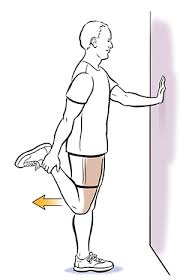
Do this three times on each leg, both before and after working out any particular muscle group.
Perform this exercise in three sets of three reps to four, with proper grip.
Activating and strengthening the muscles:
The patient works out with little to no weight and a little resistance. The patient should do 10–15 repetitions for one or two sets while holding these poses for two seconds.
The following are some instances of stretches that are done during an activity:
- Bridge Exercises
Bridges exercise the maxillary gluteus. Typically, this muscle contracts when the pelvis is moved, particularly during a squat. Maintaining strong glutes can help with a variety of lower back issues because they are an essential component of your body.
After lowering your body to the floor, take a little break before performing the exercise once more. Make 15 repetitions of this lower cross syndrome exercise. Take a minute to recover before beginning another set.
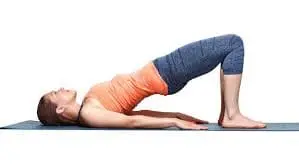
- Quadruped hip extensions:
- Before going back to the beginning posture and finishing the repetitions, the person must maintain this.
- Holding the extension for two seconds, the person does this action for at least two sets, with ten repetitions in each set.
- Plank exercises
A great core and abdominal exercise that might help with low back pain is the plank. This exercise for lower cross syndrome has an effect from the pelvis to the shoulder girdle along the spine.
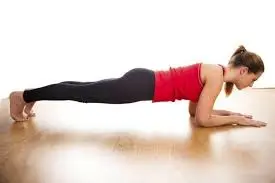
For novices, maintain this posture for a minimum of 20 seconds before going back to the initial position. Hold it for however long as possible without sacrificing form if that makes you feel more comfortable.
- Hip flexors strech exercise
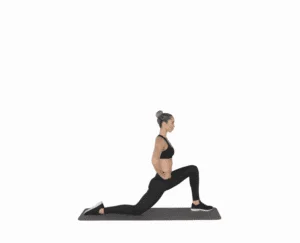
Then, squeeze your right buttock while bending forward on your left hip. Exercise selection and execution should be based on your comfort level; don’t overwork your body.
- Wall Squat exercises
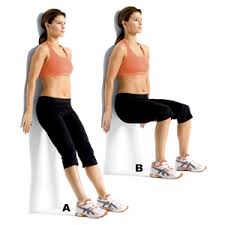
In order to add squat exercises to the progression stage, concentrate initially on strengthening the hip joint muscles during this lower cross syndrome exercise. Don’t allow your knees to slide in; keep them over your toes.
- Clam Shell exercise
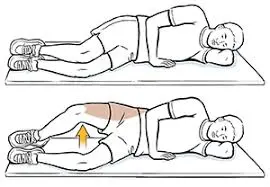
Another exercise that strengthens is the clamshell. Throughout the exercise, make sure your legs stay together and your core muscles are working. With your left knee still off the ground, raise your right knee as high as you can without raising your leg.
- Clamshell exercise with a resistance band
This crunch variation guarantees a strong core and back while targeting the glutes and hamstrings. After two seconds of holding the aforementioned motion, carefully return the knee to its initial position. Perform 20–25 reps on each side.
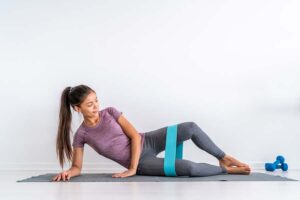
- Pelvic Tilt Exercises
The ease of use of these is immense: all you need to do is elevate your hips, bend your knees, and rest on your back. Your lower back will tense up a little before returning to its initial posture. completed three sets of this exercise each day, completing 10 to 15 repetitions with a minimum 5-second hold.
- Kneeling leg raise with back stretch
After two seconds of holding, adjust your spine to a neutral posture. To align your raised leg with your body, reach back and lift one leg until it is the same height as your body. Maintain a neutral posture for your spine. Change the legs. Back pain can result from excessive back bending.
- Lunge Stretch Exercises
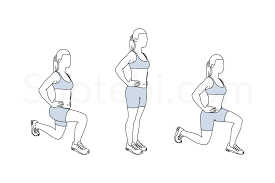
Your rear knee should practically contact the surface as you extend it. For two seconds, maintain this posture. To return to the beginning posture, stretch both knees and press through your heels. and exercise caution when doing so.
- Superman exercise
Use a plinth or yoga mat to perform the Strat Superman exercise in a prone position. Finally, before beginning to move your spine, make as much touch with your core as you can.
Lift your left arm and extend it forward until it is parallel to your body while squeezing your heart. Continue on the other side. Do not bend your lower back; instead, merely extend your leg and shoulder as far as it is comfortable.
- Bird Dog Exercise
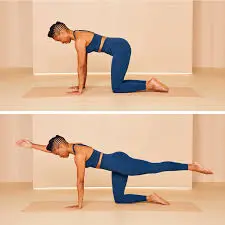
A basic core muscle strength exercise called “Bird Dog” helps to maintain a neutral spine, increase stability, and lessen or eliminate lower back pain.
Begin on all fours in a table position. On the mat, begin in the quadrupled position first. Retain your abs in a neutral position. Put your shoulders back. Go back to where you were before. There is just one round.
- Quadriceps Release With Foam Roller
You will need a foam roller for the exercises that include quadriceps release using foam rollers. Keep your lower back and lumbar region from arching or rounding; instead, support your core.
Keep an eye on sensitive areas. When you locate a tender spot, press it for ten to twenty seconds, or until the pain goes away, and then move on to another tender spot. To isolate your inner quads, spread your legs wide and rotate them outward.
- The lower back cat
Begin by placing yourself in a quadrupedal stance on the plinth or mat using both hands and knees. Return the bottom to the feet.
- Core dead bugs
Your lower back will not quite contact the floor, as you will observe. First, determine your hip’s slope. Keep your pelvic tilt constant, breathe properly, and avoid holding your breath all the time. Switch sides after slowly and deliberately extending the opposing arm and leg at the same time while bending your hips to avoid falling. completed three sets of six repetitions a day.
- A supine ball squeeze
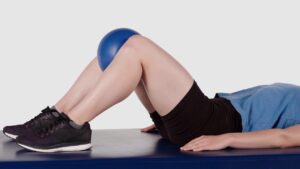
Make contact with your abdominal core muscles. After releasing the contraction and holding it for five seconds, pick up the chi balls or medicine balls. Make sure each adductor muscle contracts equally.
Lower Cross Syndrome Massage Treatment
Lower Cross Syndrome (LCS) patients may benefit from massage therapy as an adjuvant treatment to assist relieve pain, induce relaxation, enhance circulation, and ease tense muscles. It’s crucial to collaborate with a licensed, skilled massage therapist who is knowledgeable about LCS when thinking about receiving massage therapy for the disease. The following massage methods can be applied to treat LCS:
- Swedish massage: Swedish massage has the potential to enhance bodily relaxation, lessen tense muscles, and increase circulation.
- Deep tissue massage: To deal with muscle imbalances related to LCS, the massage therapist may concentrate on tight areas including the lower back muscles and hip flexors.
- Myofascial release: This method works to relieve tension and blockages in the fascia, which is the connective tissue that envelops and supports the muscles.
- Trigger point therapy: Trigger point therapy is useful for addressing specific muscle stiffness areas, like the gluteal and hip flexors, that are frequently present in LCS patients.
In cases of lower-crossed syndrome, how may yoga help?
By extending muscles and teaching long, weak muscles to become active again, yoga can help the body become more flexible. When practicing yoga, focus on stretching your hamstrings and hip flexors to balance the pelvic tension in a forward-backward manner if you suffer from low back syndrome.
Yoga might assist you in growing back previously long muscles if you have extended these muscles. You are able to initiate, stabilize, and re-support the process of growing muscle.
For example, by adding short stretch muscles to an already uneven pattern, we can create an even more complex total imbalance. First, extend the muscles that are short. Next, employ functional movement exercises such as yoga to assist in retraining muscles that were previously extended to actively support various body movements.
How to Correct Your Posture in This Situation.
Long periods of sitting in daily life lead to imbalances in the length and power of our muscles. We have heard a lot in the past few years about the negative effects of extended sitting, but athletes who do not spend most of their time sitting down might still experience lower back issues. Sitting for extended periods of time causes the front and rear pelvic muscles to become hyperactive and underactive.
How to Prevent Lower Cross Syndrome?
A person shouldn’t include additional physical activity into their daily routine if they have a sedentary lifestyle so that they are aware of the following tips for avoiding lower cross syndrome and back pain. Maintain proper form and posture, and engage in underused muscle action on a regular basis.
Summary
A postural imbalance known as Lower Cross Syndrome (LCS) is typified by weak gluteal and abdominal muscles and taut hip flexor muscles. It can result in poor posture, decreased stability and functional mobility, hip and groin pain, and lower back pain.
Maintaining proper posture, exercising frequently to develop hip and core muscles, stretching frequently, and taking frequent breaks from sitting are all crucial for preventing LCS. It’s also advantageous to listen to your body, avoid lengthy static positions, practice ergonomics, and keep a healthy weight.
In order to properly treat LCS, patients should seek appropriate treatment, such as physical therapy, which may comprise manual therapy, stretching, strengthening, posture retraining, and instruction on self-management.
Lower cross syndrome is one of the most prevalent postural disturbances that I notice in my patients as a physical therapist. It is crucial to make an appointment with a physical therapist as soon as possible if you are in pain or uncomfortable. Our goal at Samarpan Clinic is to enhance our patients’ general quality of life by providing them with respite. A group of skilled and knowledgeable physical therapists at our clinic are assisting patients in resolving symptoms of lower cross syndrome and other postural abnormalities.
FAQs
Lower cross syndrome: what causes it?
This usually occurs as a result of overactive and tight hip flexors, adductor muscles, upper and lower back extensor muscles, and calves.
What advantages can cross-leg exercises offer?
It also permits improved blood flow to certain parts of the body and increased bowel movement. Additionally, sitting cross-legged improves the range of motion and is good for the knees and other joints.
Is the syndrome of lower cross permanent?
Human bodies were meant to be in their natural state when standing and walking. Unfortunately, this means that when people sit for extended periods of time (almost an entire workday for those with “table jobs”), and over the course of years, their hip flexor and lower back muscles can become extremely tight, even as their.
How can one determine if go syndrome has diminished?
Tests for Lower Cross Syndrome
Kemp’s check A high-quality check is characterized as an assessment of the affected person’s pain. The trying-out method is commonly described as having the affected person perform extension combined with rotation of the spinal neighborhood of interest.
What results in an imbalance of muscles in the back?
In addition to weak, tight, and short muscles, imbalance can also be made worse by tension, exhaustion, and muscle overload. When the back muscles, including the abdominals, grow shorter, longed-for, or weak, an imbalance of back muscles results.
Which muscle in lower cross syndrome is weak?
Muscle weakness known as lower cross syndrome
Weakness of the gluteal muscles (gluteus maximus, gluteus medius, and gluteus minimus) and of the trunk muscles (rectus abdominis, internal oblique, external abdominis, and transverse abdominis) are linked to lower crossing syndrome.
How can lower crossed syndrome be eliminated?
Exercise can naturally aid in the treatment of lower back pain, strengthen the weak hip muscles, and preserve healthy muscle flexibility. The greatest exercises are those that focus on strengthening the flexor or abdominal muscles especially because they can either relax and release tight muscles or improve weak muscles.
What are the cross-back syndrome exercises?
As many times as you can during the day, repeat the exercise while holding this posture for three to five minutes. You can use dumbbells or resistance bands as training equipment.
What are the greatest exercises to treat or repair lower cross syndrome?
After one visit with a physical therapist, attempt these nine exercises for lower cross syndrome at home:
Pelvic Tilt Exercises
Exercises for the Squat.
Plank exercises, bridge exercises, etc.
Exercises to Stretch Your Quadriceps.
Stretching Exercises for Lunges.
Exercises for Hip Flexor Stretches:
core a lifeless bug
With a foam roller, release your quadriceps.
Exercise for Bird Dogs.
How can lower-crossed syndrome be resolved?
Certain exercises are said to be the greatest for your abdominal or hip flexor muscles because they help to relax and loosen tight muscles as well as strengthen the weak muscles that cause the LCS condition.
References
- Maurya, J. (2023, July 4). Lower Cross Syndrome – Cause, Symptoms, Treatment, Exercise. Samarpan Physiotherapy Clinic. https://samarpanphysioclinic.com/lower-cross-syndrome/
- Prajapati, D. (2023, July 19). Lower cross syndrome corrective Exercise – Samarpan Physio. Samarpan Physiotherapy Clinic. https://samarpanphysioclinic.com/lower-cross-syndrome-corrective-exercise/
- Miller, K. (n.d.). Lower Crossed Syndrome: Starting From the Center. https://blog.nasm.org/lower-crossed-syndrome

